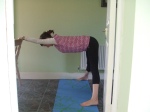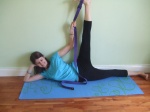The aim of this breathing exercise is to completely empty the lungs so that when you breathe in you get a complete refill of air and prana into the lungs. The air fills the lungs in 3 phases just like liquid flowing into a cup: the bottom first, then the middle and then the top. To help you breathe more consciously and thus more deeply, you position the hands in 3 different locations as the inhalation takes place. This helps you visualise the flow of the breath which makes the exercise even more powerful.
Note: You never actually empty the lungs completely, as to do so would make the lungs collapse. But you are aiming for nearly empty.
As you exhale, you make the sound A-U-M: ‘A’ as the breath leaves the upper part of the lungs, ‘U’ as it leaves the middle part, and ‘M’ as it exits the lower part. ‘Om’ is the favorite mantra of the yogis because it is believed to be the sound that brought the universe into existence.
- Lie on your mat with your knees bent and hip-width apart. (You can also do the exercise sitting up).
- Lengthen your neck by clasping your hands behind your head and lifting it off the floor slightly. Slide your hands over the back of the head towards the crown, feeling your neck release to its maximum. Then carefully, replace the back of the head on the floor.
- Place your finger tips on your lower ribs with your fingers, loose and relaxed.
- Look up at the ceiling. Open your eyes as wide as possible, look down at the tip of the nose and then gradually, draw the eyelids down over the eyes.
- Inhaling, take your right shoulder off the floor and broaden it out to the side. Exhaling, replace it down on the floor again. Repeat on the left side.
- Allow the skin on your face to relax and soften. Also soften the skin on the soles of the feet and on the palms of your hands. Soften the inner ears.
- Inhale deeply, and exhale through the mouth with a nice, long sigh.
- Go back now to breathing in and out through the nose only. Every time you exhale, allow the back to settle into the floor.
- Begin now to observe your breath. Listen to its sound: ‘So’ as you inhale, and ‘Ham’ as you exhale. Feel the throat soften and relax.
- The next time you inhale, visualise the breath entering the bottom part of the lungs where your fingers are located. As you exhale, make the sound ‘A’ (as in father). Allow the sound to vibrate for the entire duration of the out-breath. Continue for 6 breaths.
- Now, place your fingers into your armpits. As you inhale, visualise the breath entering the middle part of the lungs only, again in line with where the fingers are positioned. As you exhale, make the sound ‘U’ (as in room). Continue for 6 breaths.
- Now, place your fingers on your collar bones. As you inhale, visualise the breath entering the top part of the lungs, just under your fingers. As you exhale, make the sound ‘M’ (as in hum). Continue for 6 breaths.
- Go back to your normal breathing for a few breaths and relax the arms down by your sides.
- Now, think about putting it all together. Place the fingers on the lower ribs again. Inhale into the lower lungs. As you feel the breath moving up into the middle lungs, move the fingers into the armpits. Then place the fingers on the collar bones as the breath enters the top part of the lungs. As you exhale, relax your arms by your sides and say your mantra A-U-M, as the breath gradually departs from the body: ‘A’ as the breath leaves the upper lungs, ‘U’ as it leaves the middle, and ‘M’ as it exits the lower lungs. When you get to ‘M’, see can you squeeze that last bit stale bit of air out of the lungs. Continue for 6 breaths.
- Return to your normal breathing, paying more attention to the inhalation to help you become more alert. Stretch your arms behind you and the legs out in front of you. Inhaling, stretch the entire right side of the body. Exhale, and release. Repeat on the left. Repeat once more on both sides.
- Roll over on to one side, and supporting the back of the head with one hand, come back up to sitting again.






